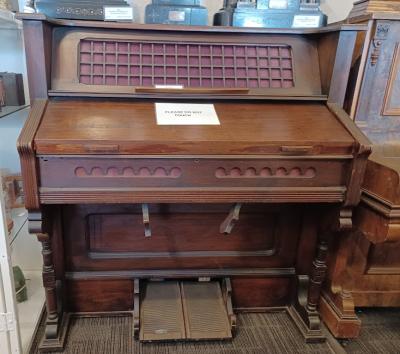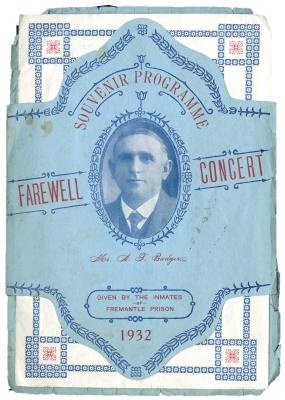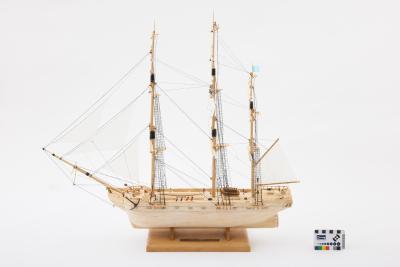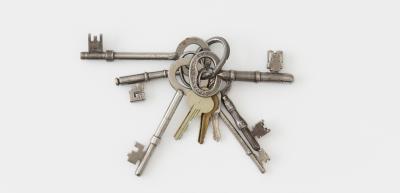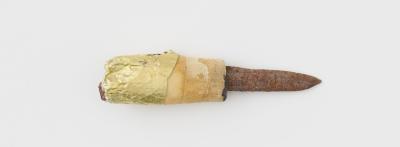REED ORGAN
1896 - 1898Large, wooden, Farrand & Votey, upright, reed organ. Large, rectangular, wooden, upright organ, with a light wood, possibly walnut and maple, casing. In the centre of the organ is a single set of piano keys, in black and white, notes FF to ffff, with 15 draw-stops, four reed sets, plus 13 notes sub-bass. On the front of the case, underneath the keys, is a panel of fillagree wood in a scroll pattern, with a dark red material set behind. Above the keys is another panel of filigree wood with a matching scroll pattern at each end, and a crosshatching patten in the centre. This panel is also lined behind in dark red material. Attached to the top of the organ is a decorative, carved, wooden panel, with a diamond shaped mirror in the centre. There is a shallow shelf at the top of the panel, with turned wooden columns on either side. At the base of the piano are two, wide, foot pedals. The organ is stamped with the serial number, '44806'.
The serial number on this reed organ dates its manufacture to c1896. This organ is likely to be the one purchased in 1898 for the Fremantle Prison Anglican Chapel, to replace the old Harmonium (1995.63) which was in need of repairs. Initially, a Crescent Organ was purchased from A. & E. Humphries in London, through their local agent Shotter & Co, in Perth (correspondence dated 10 August 1897 and 26 November 1901). This instrument, however, proved to be 'too weak in tone' and was replaced with 'the one we have at the moment' for a further 22 pounds 100s (see requisition dated 12 July 1898). The new replacement was this Farrand & Votey reed organ, which was used in the Anglican Chapel until the Prison's closure in 1991. (See repairer quote dated 29 January 1909 referring to a Farrand & Votey. See also SRO file AU WA S3054- cons968 1909/0320 Title: 'Organs in Churches. Fremantle Prison. Tuning and repairs to').
Details
Details
'44806'
The Convict Establishment placed great emphasis on religious teaching and observance of ritual. It was believed that rehabilitation or reform of a criminal was best handled by the church. Therefore, convicts were required to attend a prayer service every morning, and church twice on Sundays. Sunday church attendance remained compulsory for all inmates until 1931.
The Anglican Chapel was constructed as the centrepiece of the Prison. The large, open building looked out across the Prison gates towards the town of Fremantle. Fully completed in 1858, the Anglican Chapel is the only room in the Main Cell Block without bars on the windows. This was to create the impression of trust, to aid the prisoner’s path towards redemption. After continuous agitation from Catholic prisoners and officers for their own chapel, a Catholic Chapel was also opened at Fremantle Prison in 1862. Both Chapels had a church choir, and prisoners were rewarded for regular attendance at choir training.
Between the 1880s and the early 1900s, reed organs were mass produced in the United States and exported to other countries for use in homes, small churches and chapels. These instruments generate sound as air flows past a vibrating piece of thin metal, known as the ‘reed’, which sits within the frame. Reed organs proved very popular, as they offered a cheaper, and more easily maintained, alternative to a piano.
In 1898, the Anglican Chapel Harmonium (also in the Fremantle Prison Collection - 1995.63), needed replacing, and a reed organ was purchased. This Farrand and Votey reed organ is likely that replacement instrument purchased. Records show that initially a Crescent Organ was purchased from A. & E. Humphries of London, through their local agent Shotter & Co. in Perth. However this instrument proved to be, “too weak in tone”, and was quickly replaced with the Farrand and Votey Organ.
Originally founded in 1881 as the Detroit Organ Company in Michigan, USA, The Farrand & Votey Organ Company was established under the 'Farrand & Votey' name in 1887. The firm built pipe organs, reed organs and pianos. Edwin Scott Votey, who purchased the Detroit Organ company in 1883 with a successful music dealer C. J. Whitney, received his early training at the Estey firm. In 1895 Votey invented the Pianola. In 1901 the Farrand & Votey company was sold to George S. Hutchings, a Boston organ builder, and the firm's name changed to Hutchings-Votey.
The Estey pedal reed organ in the Fremantle Prison Collection (2016.2), was purchased in 1902, after the harmonium in the Prison’s Roman Catholic Chapel needed replacing. The Prison’s Superintendent and the Roman Catholic Chaplain corresponded for a long time regarding funds for a new instrument, and it was finally purchased from Shotter, Row and Co. in Perth, for the sum of £35.
Two other reed organs are in the Fremantle Prison Collection; a Wertheim Hapsburg organ and the Wilcox and White. Both were found on site without attached documentation and their provenance is yet to be established.
The Wertheim Hapsburg reed organ (1995.115), was imported from an undisclosed manufacturer in New York, and was originally sold under the label 'Hapsburg Organ'. The Wertheim family was a famous piano and harmonium importing family located in Melbourne at the beginning of the twentieth century.
The fourth reed organ in the Fremantle Prison Collection, the Wilcox and White pedal reed organ (1995.116), has attached to its surface a circular copper medallion, with a crowned bust of Queen Victoria for her Centenary International Exhibition, shown in Melbourne in 1888. This exhibition was held to celebrate a century of European settlement in Australia. Wilcox and White were an American manufacturing company of reed organs, who established themselves in 1876 or 1877, in Meriden, Connecticut. White was the organ builder, whilst Wilcox was a silversmith. The company went bankrupt in 1921, and records regarding sales seem to have been lost or destroyed.
